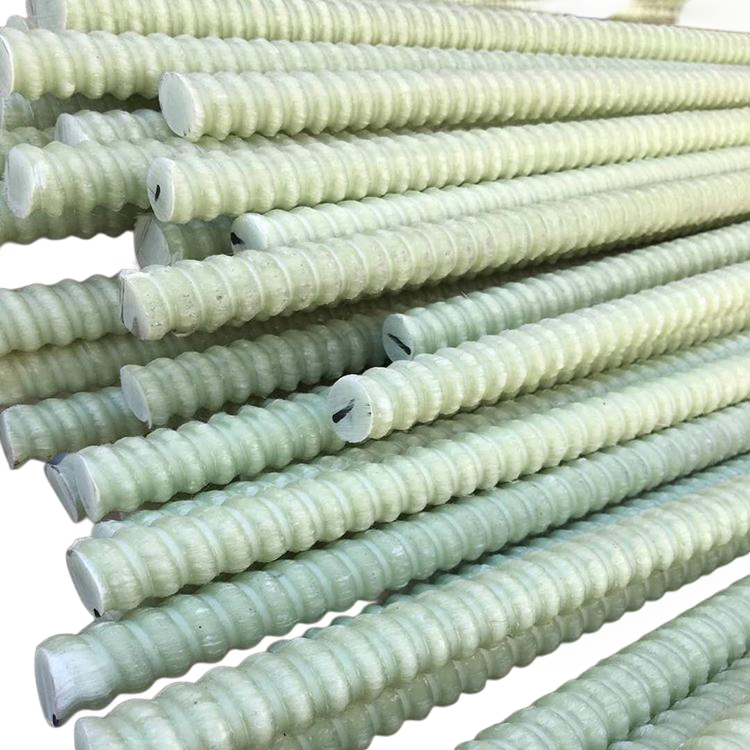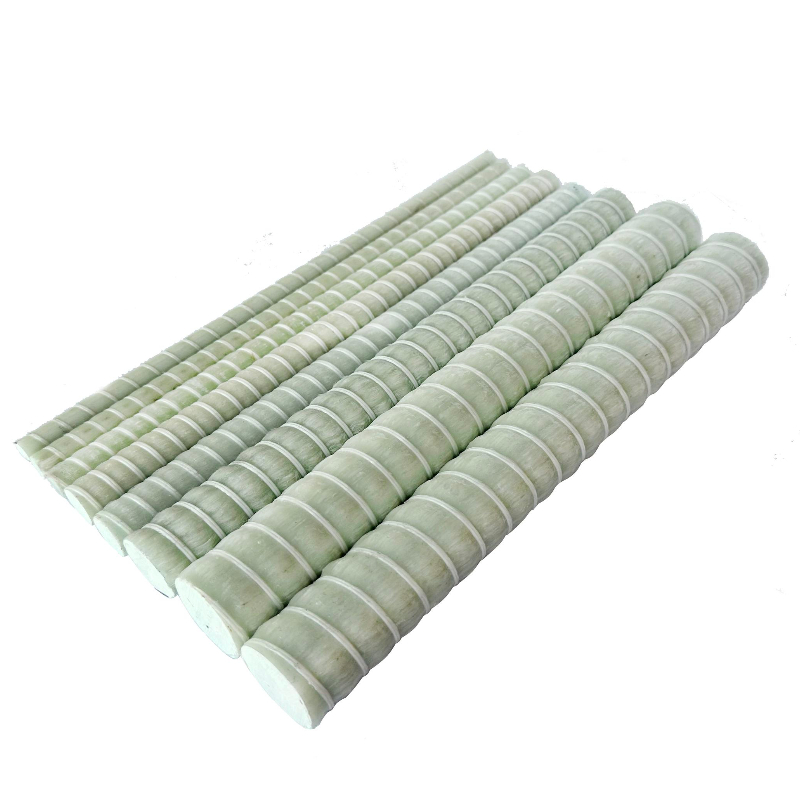Introduction
In the realm of modern construction, the demand for materials that offer superior performance, durability, and economic efficiency is ever-increasing. One such material that has garnered significant attention is glass fiber rebar. This composite reinforcement material is transforming the way engineers and architects approach structural design, particularly in environments where traditional steel reinforcement presents limitations. This article delves into the composition, advantages, and applications of glass fiber rebar, providing a comprehensive analysis of its role in contemporary construction practices.
Composition and Manufacturing of Glass Fiber Rebar
Glass fiber rebar, also known as glass fiber reinforced polymer (GFRP) rebar, is a composite material that combines the high tensile strength of glass fibers with the durability of a polymer resin matrix. Typically, E-glass fibers are used due to their excellent mechanical properties and cost-effectiveness. The fibers are impregnated with a resin—often epoxy, vinyl ester, or polyester—to form a solid rod through a process called pultrusion. This method ensures consistent cross-sectional properties and allows for the production of rebar in various sizes and shapes.
Pultrusion Process
The pultrusion process is central to the manufacturing of glass fiber rebar. Continuous strands of glass fibers are pulled through a resin bath, ensuring thorough impregnation. The saturated fibers are then guided through a heated die, where the composite material cures and hardens into the desired shape and size. The result is a high-strength, lightweight reinforcement bar with properties that can be tailored through adjustments in fiber orientation and resin type.
Material Properties
The mechanical characteristics of glass fiber rebar are largely influenced by the fiber content and the type of resin used. Key properties include high tensile strength, low weight, non-conductivity, and excellent corrosion resistance. The tensile strength of glass fiber rebar typically ranges from 600 to 1,200 MPa, surpassing that of traditional steel rebar on a strength-to-weight basis. The density of glass fiber rebar is approximately one-quarter that of steel, facilitating easier handling and reduced transportation costs.
Advantages of Glass Fiber Rebar
The adoption of glass fiber rebar in construction projects is driven by several compelling advantages, positioning it as a competitive alternative to conventional steel reinforcement.
Corrosion Resistance
Unlike steel, glass fiber rebar is inherently resistant to corrosion, making it ideal for structures exposed to harsh environmental conditions. This includes marine environments, chemical plants, and areas where de-icing salts are prevalent. The absence of corrosion-related deterioration extends the service life of structures and reduces maintenance costs significantly.
Lightweight Characteristics
The low density of glass fiber rebar contributes to its ease of transport and installation. Workers can handle the material without the need for heavy lifting equipment, enhancing on-site safety and efficiency. This is particularly advantageous in remote locations or in applications where weight reduction is a critical design consideration.
Non-Conductivity
Glass fiber rebar's non-conductive nature eliminates the risk of electrical hazards associated with steel reinforcement in high-voltage environments. This property is essential in the construction of power plants, industrial facilities, and structures housing sensitive electronic equipment. It prevents electromagnetic interference and ensures the safety of both personnel and equipment.
Thermal Insulation
The low thermal conductivity of glass fiber rebar helps reduce thermal bridging in reinforced concrete structures. This enhances the energy efficiency of buildings by minimizing heat loss or gain through structural elements. Such insulation properties contribute to meeting stringent energy codes and sustainability goals in modern construction.
Comparative Analysis with Steel Rebar
While steel rebar remains the most commonly used reinforcement material, glass fiber rebar offers several distinct advantages that warrant consideration, especially in specialized applications.
Mechanical Performance
Steel rebar possesses a high modulus of elasticity, around 200 GPa, which contributes to the stiffness of reinforced concrete structures. In contrast, glass fiber rebar has a modulus of elasticity ranging from 35 to 55 GPa. While this means that glass fiber reinforced structures may exhibit greater deflection under load, designs can be adjusted to compensate for this difference. Additionally, the higher ultimate tensile strength of glass fiber rebar can enhance the load-bearing capacity of structures when appropriately designed.
Durability and Maintenance
The long-term performance of a structure is significantly influenced by the durability of its reinforcement. Steel rebar is susceptible to corrosion, leading to spalling of concrete and loss of structural integrity over time. Glass fiber rebar's resistance to environmental degradation ensures consistent performance, reducing the need for repairs and associated costs. This aspect is particularly critical in infrastructures like bridges and tunnels, where maintenance can be disruptive and expensive.
Economic Considerations
While the initial material cost of glass fiber rebar may be higher than that of steel, the total life-cycle cost often favors glass fiber rebar due to reduced maintenance and longer service life. When factoring in the costs associated with corrosion-related repairs and downtime, glass fiber rebar presents a cost-effective solution in many scenarios. Furthermore, the lightweight nature of glass fiber rebar can lower transportation and labor costs, contributing to overall project savings.
Applications of Glass Fiber Rebar
The versatility of glass fiber rebar makes it suitable for a wide range of applications across various sectors. Its unique properties enable its use in environments where traditional reinforcement materials are less effective or pose challenges.
Marine and Coastal Structures
In marine environments, structures are constantly exposed to saltwater, which accelerates the corrosion of steel rebar. Glass fiber rebar's resistance to chloride-induced corrosion makes it an ideal choice for building seawalls, piers, docks, and offshore platforms. Its use extends the lifespan of these structures and reduces the frequency of maintenance interventions.
Transportation Infrastructure
Bridges, highways, and tunnels benefit from the durability of glass fiber rebar. De-icing salts used on roadways can cause significant corrosion damage to steel-reinforced concrete. Incorporating glass fiber rebar mitigates this issue, enhancing the structural integrity and safety of transportation infrastructure. Additionally, the non-magnetic properties are advantageous in tunnels with electronic monitoring and control systems.
Industrial Facilities
Chemical plants and industrial facilities often deal with corrosive substances that can compromise steel reinforcement. Glass fiber rebar provides a solution by offering chemical resistance, ensuring that structural elements maintain their integrity in aggressive environments. This not only improves safety but also reduces long-term maintenance costs.
Electromagnetic-Sensitive Structures
In facilities such as hospitals, laboratories, and airports, electromagnetic interference can disrupt sensitive equipment. The non-conductive nature of glass fiber rebar eliminates the risk of interference, making it suitable for these applications. Its use ensures that critical equipment functions without disturbance, which is essential in medical and technological settings.
Historical Renovations
When renovating historical structures, preserving the original appearance while enhancing structural capacity is often a challenge. Glass fiber rebar, with its high strength and low visibility, can reinforce existing elements without altering the aesthetic integrity of heritage buildings. Its corrosion resistance ensures that the reinforcement does not cause future damage to the original materials.
Case Studies Highlighting Glass Fiber Rebar Use
The practical benefits of glass fiber rebar have been demonstrated in numerous projects around the globe. These case studies provide valuable insights into its performance and potential applications.
Parking Garage Structures
In North America, several parking garages have incorporated glass fiber rebar to combat the corrosive effects of de-icing salts and vehicle emissions. The use of glass fiber rebar has resulted in structures with extended service lives and reduced maintenance needs. Evaluations have shown that these garages remain in excellent condition years after construction, validating the material's effectiveness.
Bridge Deck Overlays
The Sierrita de la Cruz Creek Bridge in Texas utilized glass fiber rebar in its deck overlay to address issues with rebar corrosion. The project demonstrated that glass fiber rebar could be successfully integrated with existing structures, providing a durable solution that withstands environmental stresses. Monitoring has indicated no signs of deterioration, supporting the material's long-term viability.
Airport Runway Construction
At the Doha International Airport in Qatar, glass fiber rebar was used in the runway construction due to its non-magnetic properties and resistance to extreme temperatures. The material's performance under heavy load conditions and in a harsh desert climate has reinforced confidence in its suitability for critical infrastructure projects.
Design Considerations and Standards
Integrating glass fiber rebar into structural designs requires careful consideration of its mechanical properties and compliance with relevant standards. Engineers must adapt traditional design approaches to accommodate the differences between glass fiber rebar and steel.
Structural Design Adaptations
Due to the lower modulus of elasticity of glass fiber rebar, structures may experience greater deflections under load. Design codes, such as the American Concrete Institute's ACI 440.1R, provide guidelines for calculating deflections and cracking in glass fiber reinforced structures. Engineers must ensure that serviceability limits are met, potentially by increasing section sizes or incorporating additional reinforcement.
Fire Performance
The performance of glass fiber rebar in fire conditions is an important consideration. While the resin matrix can degrade at high temperatures, concrete cover provides a protective barrier that delays heat exposure. Fire-resistant resins and coatings can enhance performance, and design modifications may be necessary to meet fire safety requirements.
Anchorage and Bonding
The bond between glass fiber rebar and concrete differs from that of steel due to surface characteristics. Surface treatments, such as sand coating or ribbed profiles, improve the mechanical interlock and bond strength. Design specifications must account for these differences to ensure adequate load transfer and structural integrity.
Challenges and Limitations
Despite its benefits, the use of glass fiber rebar is not without challenges. Understanding these limitations is essential for making informed decisions about its implementation.
Brittleness
Glass fiber rebar exhibits a linear elastic behavior until failure, with little to no yielding. This lack of ductility means that structures may not exhibit warning signs before failure, as is often the case with steel-reinforced structures. Designs must incorporate adequate safety factors and consider the implications of brittle failure modes.
Cost Factors
The higher initial cost of glass fiber rebar can be a deterrent, particularly in cost-sensitive projects. While life-cycle costing demonstrates long-term savings, budget constraints may limit its adoption. Market maturity and increased production volumes are expected to drive down costs over time, enhancing competitiveness.
Temperature Sensitivity
Exposure to elevated temperatures can affect the mechanical properties of glass fiber rebar. The resin matrix may soften or degrade, leading to reduced strength. Applications involving high-temperature environments require careful material selection and potentially additional protective measures to ensure performance.
Future Outlook and Research Directions
The potential of glass fiber rebar is driving ongoing research and development efforts aimed at enhancing its properties and broadening its applicability.
Material Innovations
Advancements in fiber technology, such as the development of higher-strength glass fibers and hybrid composites, are improving the performance of glass fiber rebar. Research into novel resin systems is focused on enhancing fire resistance, durability, and environmental sustainability. These innovations aim to address current limitations and open new avenues for application.
Standardization Efforts
International bodies and industry groups are working towards the standardization of design codes and certification processes for glass fiber rebar. The development of unified standards will facilitate engineer confidence and promote wider adoption. Efforts include comprehensive testing programs to validate performance and inform guideline development.
Environmental Considerations
Environmental sustainability is a growing concern in construction. Glass fiber rebar offers benefits in terms of longevity and reduced material usage due to its high strength-to-weight ratio. Research into recyclable resins and fibers is ongoing, aiming to improve the material's environmental profile and support circular economy principles.
Conclusion
The integration of glass fiber rebar into construction practices represents a significant step forward in addressing the challenges of durability, maintenance, and performance in reinforced concrete structures. Its unique properties enable solutions that extend service life, reduce costs, and meet the demands of specialized applications. While challenges remain, particularly regarding design adaptations and initial costs, the ongoing advancements in material science and engineering practices are paving the way for broader acceptance. As the industry moves towards more sustainable and resilient infrastructure, glass fiber rebar is poised to play a crucial role in shaping the future of construction.



























